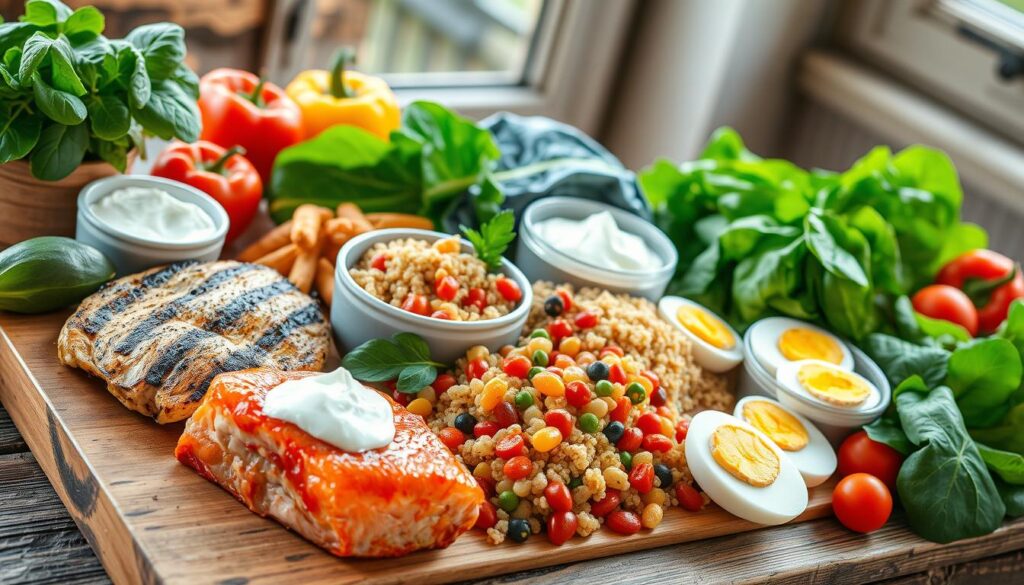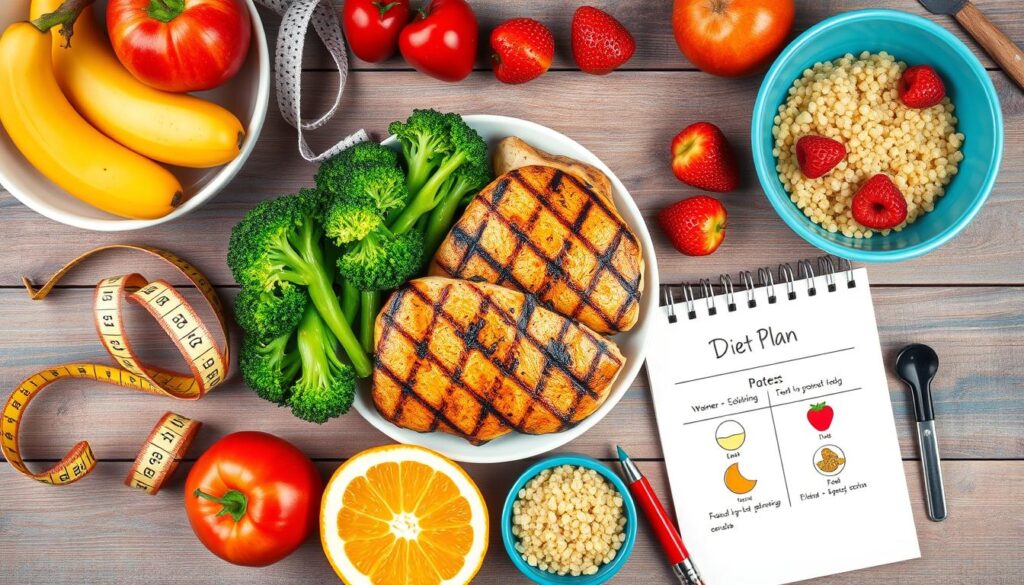If you’re a male wanting to lose fat and get lean, a good diet plan is key. This guide will show you how to reach your fat loss goals fast. It helps with losing belly fat, getting more muscle definition, and improving health.
The heart of any good fat loss plan is a calorie deficit. This means eating fewer calories so your body uses fat for energy. But, it’s important to not lose too much muscle. This plan will teach you how to keep the right balance of nutrients and eat carbs and protein wisely.
Key Takeaways:
- Achieving a calorie deficit is essential for fat loss, but it must be balanced with adequate protein intake to preserve muscle mass.
- Strategically managing macronutrient ratios, such as carbohydrates and protein, can optimize fat burning and support lean muscle development.
- Implementing a high-protein diet plan, along with a structured exercise regimen, can accelerate fat loss and enhance overall body composition.
- Timing your carbohydrate intake around workouts can provide the necessary energy for exercise while promoting fat loss during the rest of the day.
- Breaking through fat loss plateaus requires a multifaceted approach, including adjusting calorie intake, macronutrient ratios, and training strategies.
Understanding the Science Behind Male Fat Loss
To lose fat as a male, you need to know the science. The key is to have a calorie deficit. This means burning more calories than you eat. Your body then uses fat for energy, slowly losing weight.
Hormones are very important for losing fat. Growth hormone (GH) helps you lose fat and keep muscle. It also makes your metabolic rate faster, helping you stay lean and strong.
The Role of Caloric Deficit in Fat Loss
A calorie deficit is the base of any good fat loss plan. Eating fewer calories makes your body use fat for energy. This leads to losing body fat slowly.
Finding the right balance between calories eaten and burned is key. It helps you lose fat without losing muscle.
How Hormones Affect Weight Loss
Hormones like growth hormone, testosterone, and thyroid hormones control your metabolic rate and fat burning. Keeping these hormones balanced through diet and lifestyle can boost your fat loss.
Metabolic Rate and Body Composition
Your metabolic rate and body composition affect how well you lose fat. People with more muscle burn more calories at rest. Keeping or gaining muscle while losing calories helps you burn fat better.
“The percentage of individuals who lose weight and successfully maintain the loss has been estimated to be as small as 1 to 3 percent.”
Knowing the science of male fat loss is key to a good fat loss plan. Focus on a calorie deficit, manage hormones, and improve your metabolic rate and body composition. This way, you can reach your fat loss goals.
Getting Started: Essential Components of a Fat Loss Diet Plan for Male
Starting a fat loss journey as a male needs a good nutrition plan. Your diet should have three main parts: lots of protein, right portions, and smart carb use. These habits help you succeed in the long run.
Protein is key for losing fat. Eat lean proteins like chicken, fish, eggs, and tofu. These foods keep you full and help keep your muscles strong. Try to have protein at every meal.
Controlling how much you eat is also important. It’s easy to eat too much. Use your hand or a small plate to judge your food. It’s not just what you eat, but how much.
Managing carbs is also vital. Carbs are important, but choose the right kinds like whole grains and fruits. Try different carb plans to find what works for you.
These steps are the start of a good fat loss diet plan for males. Focus on protein, portion control, and carbs. This will help you reach your body goals.
| Key Component | Description |
|---|---|
| High-Protein Foods | Lean protein sources like chicken, fish, eggs, lentils, and tofu support muscle maintenance during weight loss and promote satiety. |
| Portion Control | Utilizing visual cues and smaller plates can help you manage your calorie intake and avoid overeating. |
| Carbohydrate Management | Choosing whole, fiber-rich carb sources and experimenting with low-carb or carb cycling approaches can support your fat loss goals. |
“A successful fat loss diet plan for males should include a balanced approach to nutrition, focusing on high-protein foods, controlled portions, and strategic carbohydrate intake.”
Creating Your Calorie Deficit Strategy
Achieving a calorie deficit is key for losing fat. It helps you use your body’s fat for energy. Let’s look at how to make a plan that works for you.
Calculating Your Daily Caloric Needs
First, find out how many calories you need each day. Your age, gender, height, weight, and how active you are matter. For example, a sedentary male aged 19-20 might need 2,600 calories. An active one might need up to 3,000.
For women aged 19-25, sedentary ones might need 2,000 calories. Active ones might need 2,400.
Setting Realistic Weight Loss Goals
After knowing your daily calorie needs, set realistic weight loss goals. The CDC says to aim for 1-2 pounds a week. That’s a calorie deficit of 500-1,000 calories a day.
Starting with a 500-calorie cut is a good idea. It helps you lose 1 pound a week without harming your health.
Tracking Your Progress
It’s important to track how you’re doing. Weigh yourself often, take body measurements, and take progress photos. This helps you see what’s working and make changes if needed.
By following these steps, you can make a calorie deficit strategy that helps you lose fat. Remember, being consistent and patient is important for reaching your goals.
Mastering Macronutrient Ratios for Optimal Fat Loss
For men, losing fat often means getting the right mix of proteins, carbs, and fats. There’s no single way to do it. But knowing how each one works can help you make a plan that fits you.
Protein is key for keeping muscle while losing weight. Eat 10-35% of your calories from protein-rich foods like lean meats and eggs. Carbs should be 45-65% of your diet, focusing on whole grains and veggies. Fats, making up 20-30% of your diet, are important for hormones and absorbing nutrients.
Try different ratios to see what works for you. Think about how active you are, your metabolism, and body shape. A good start is the 40/40/20 rule: 40% protein, 40% carbs, and 20% fat.
Using a calorie and macronutrient app can really help. It lets you track what you eat and adjust to meet your goals. This way, you fuel your body right for losing fat and keeping muscle.
“The right macronutrient balance is the foundation for sustainable fat loss and muscle preservation.”
Remember, everyone is different when it comes to macronutrient ratios. Be open to change, listen to your body, and tweak your plan as you go. This will help you find the best mix for your fat loss journey.
Strategic Carbohydrate Management for Fat Loss
Managing carbs is key for men who want to get fit. The right carb plan can help you look lean and strong. We’ll look at how to time carbs, compare low-carb and moderate-carb diets, and explore carb cycling.
Timing Your Carb Intake
When you eat carbs matters a lot. Eating carbs before and after working out gives you energy and helps you recover. Eating fewer carbs when you’re not working out helps burn fat and stay in a calorie deficit.
Low-Carb vs. Moderate-Carb Approaches
Both low-carb and moderate-carb diets can help with fat loss. A low-carb diet starts fat burning. But, a moderate-carb diet might be easier to stick to for longer. Try both to see what works best for you.
Carb Cycling Techniques
- Switch between high and low carb days based on how active you are. Eat 2-2.5 grams of carbs per pound of body weight on high days. On low days, eat about 0.5 grams per pound.
- Try a 3-day low-carb (100-125 grams) followed by 2-day high-carb (175-275 grams) cycle. This gives your body fuel and recovery.
Carb cycling isn’t for everyone, especially those with adrenal issues. Talk to a doctor before trying it.
“Carb cycling lets your body burn fat instead of carbs and muscle, especially during breaks between high and low-carb days.”
By managing carbs well, you can get the most out of your workouts. Try different plans, watch how you do, and adjust as needed. Find what works best for you.
High-Protein Diet: The Foundation of Male Fat Loss
A high-protein diet is key for losing body fat. You should eat 1.6 to 2.2 grams of protein for every kilogram of your weight. This diet keeps your muscles strong while you’re losing fat.
Eat lean proteins like chicken, turkey, fish, egg whites, and low-fat dairy. These foods make you feel full and stop cravings. Protein shakes are also good for meeting your protein needs and controlling hunger.
| Protein Sources | Protein Content (per 100g) |
|---|---|
| Chicken Breast | 31g |
| Tuna (canned) | 25g |
| Eggs | 13g |
| Cottage Cheese | 11g |
| Almonds | 21g |
A high-protein diet is just one part of your fat loss diet plan for male success. You also need to eat fewer calories, watch your carbs, and exercise regularly. These steps help you lose fat and build lean muscle.
“A high-protein diet is the foundation of any effective male fat loss plan. It helps preserve your valuable muscle mass while you’re in a calorie deficit to burn fat.”

Meal Timing and Frequency: Structuring Your Eating Schedule
Changing how you eat can really help with intermittent fasting, meal timing, and exercise routine for losing fat. Plan your meals well to give you energy for workouts, help you recover, and maybe even burn more fat.
Pre and Post Workout Nutrition
Eating right before and after a workout is very important. It keeps your energy up, helps muscles grow, and speeds up fat loss. Eat a meal or snack with protein and carbs 30-60 minutes before your workout. This gives you the energy and nutrients you need.
Right after your workout, drink a protein shake or eat a meal with lots of protein. This helps your muscles recover and get the nutrients they need.
Night-time Eating Strategies
Eating late at night can be tricky. Eating carbs in your last meal might slow down fat loss. Try not to eat carbs in your last meal to help your body burn fat while you sleep. You might want to try intermittent fasting or eating only during certain times to improve your night routine.
“Mice fed with a high-fat diet during their active period gained less weight than those fed the same diet during rest.”
Finding the best meal timing and frequency is important. Try different ways and see how your body reacts. Make changes to your exercise routine and meal timing as needed.
Breaking Through Fat Loss Plateaus
Reaching a weight loss plateau can be frustrating. But don’t lose hope. You can break through and keep going towards a leaner, healthier body. The trick is to change how you approach things to challenge your body and boost your metabolic rate.
First, look at your calorie deficit. It might be time to adjust how many calories you eat. Try to cut calories a bit, not too much. This helps avoid getting stuck in a plateau.
- Try carb cycling or intermittent fasting to mix up your exercise routine and keep your body guessing.
- Make your workouts harder to push fat loss. High-intensity interval training (HIIT) is great for this.
- Make sure you sleep well and manage stress. These things can really help with weight loss.
Remember, staying consistent is important. Don’t skip workouts, as it can make you skip more. Stick to your plan and be ready to make changes. With hard work and a flexible approach, you can beat any weight loss plateau and reach your goals.
| Tip | Benefit |
|---|---|
| Increase Protein Intake | Protein digestion can boost calorie burning by 20-30%, more than twice as much as fat or carbs. |
| Avoid Alcohol | Alcohol can slow down fat burning and make belly fat worse. |
| Consume More Fiber | Fiber, especially soluble fiber, can help break through a weight loss plateau. |
| Drink More Water | Plain water can boost metabolism, especially when consumed before meals, aiding in weight loss over time. |

By using these tips and staying committed, you can beat any fat loss plateau. Remember, being consistent and flexible are key to success.
Managing Cravings and Building Healthy Habits
Reaching your fitness goals can be tough. Cravings and old habits can get in the way. But, with the right strategies, you can beat these challenges and live a healthy life.
Psychological Aspects of Dieting
Dieting is as much a mental battle as it is physical. It’s important to tackle the mental side of eating. Use portion control, intermittent fasting, and a high-protein diet to fight cravings and stay full.
- Set clear, achievable goals to stay motivated and track your progress.
- Visualize yourself reaching your target weight and the benefits it will bring.
- Identify your triggers and develop strategies to avoid or manage them, such as keeping healthy snacks on hand.
Implementing Cheat Meals Effectively
Having an occasional cheat meal can actually help you stick to your diet. Enjoying these treats keeps you motivated and stops you from feeling deprived.
- Schedule a weekly cheat meal to look forward to, but keep portions reasonable.
- Choose foods you genuinely enjoy, rather than mindlessly consuming high-calorie items.
- Get right back on track with your healthy eating plan after your cheat meal.
Building healthy habits, like meal prepping and making smart choices when dining out, supports your fat loss journey. Remember, being consistent and sustainable is key to reaching your fitness goals.
| Habit | Benefit |
|---|---|
| Meal Preparation | Ensures you have nutritious, portion-controlled meals on hand |
| Mindful Dining | Helps you make healthier choices when eating out |
| Regular Exercise | Boosts metabolism and supports fat loss |
| Adequate Sleep | Regulates hormone levels and curbs food cravings |
Remember, losing weight is a journey, not a destination. By tackling the mental side of dieting and building healthy habits, you’ll be on your way to reaching your fat loss goals.
Supplementation Strategies for Enhanced Fat Loss
When you start your fat loss diet plan for male, think about adding some supplements. Arginine is a good amino acid that might boost your growth hormone and metabolism. Take 3-6 grams of arginine in the morning and before bed.
Also, high-quality protein powders are great for your diet. They help you get enough protein when you’re losing fat. Omega-3 fatty acids in fish oil can reduce inflammation and improve health. Green tea extract can help burn fat and improve your body shape.
Always talk to a healthcare professional before starting new supplements. This is especially true if you have health issues or take medicines. Using supplements wisely, along with a good diet and exercise, can help you reach your goals.


A Life-Changing Experience with This Weight Loss Supplement (Nagano Tonic)
I’ve always struggled with finding a weight loss solution that actually works for me. Like many, I’ve tried numerous diets, exercise routines, and supplements over the years—some worked for a short time, but nothing ever gave me long-term results. That was until I decided to try the weight loss supplement I found : Link to the Supplement.
From the moment I started using it, I noticed a difference. Not only did I feel more energized, but my cravings also became more manageable. The best part? I started seeing results much quicker than I anticipated! Over the course of just a few weeks, I noticed a significant reduction in belly fat and overall weight loss that I hadn’t been able to achieve before.
What makes this supplement stand out from all the others I’ve tried is how it supports me in my daily routine without any jitters or energy crashes. I’m able to stay focused and motivated, which has made it easier to stay on track with my diet and exercise plan.
This product truly exceeded my expectations, and I feel more confident and healthier than ever before. If you’re struggling with your weight loss journey like I was, I highly recommend giving this supplement a try. It’s been a game-changer for me, and I’m sure it can work wonders for you too!
Contant Them on email .. tonicnagano50@gmail.com
I’ve tried so many weight loss products over the years, but nothing worked like this supplement! Since I started using it, I’ve noticed a big difference in my energy levels and appetite control. In just a few weeks, I’ve lost weight and feel so much better. It’s been easy to stick with, and the results speak for themselves. Highly recommend this to anyone looking to make a real change!
I was skeptical at first, but this supplement has truly made a difference in my weight loss journey. I’ve lost weight without feeling deprived or sluggish. My cravings are under control, and I feel more confident in my body. It’s easy to incorporate into my daily routine, and the results speak for themselves. I’m so glad I gave it a try!
Thanks David, i do use the link to make my purchase. you can get too here http://surl.li/iasppy
I’ve tried so many weight loss products, but this one has been by far the most effective. In just a few weeks, I’ve noticed a visible difference in my body and energy levels. It’s helped me stay on track without the constant hunger pangs and cravings. I’m really happy with my progress and can’t wait to see where I’ll be in another month!